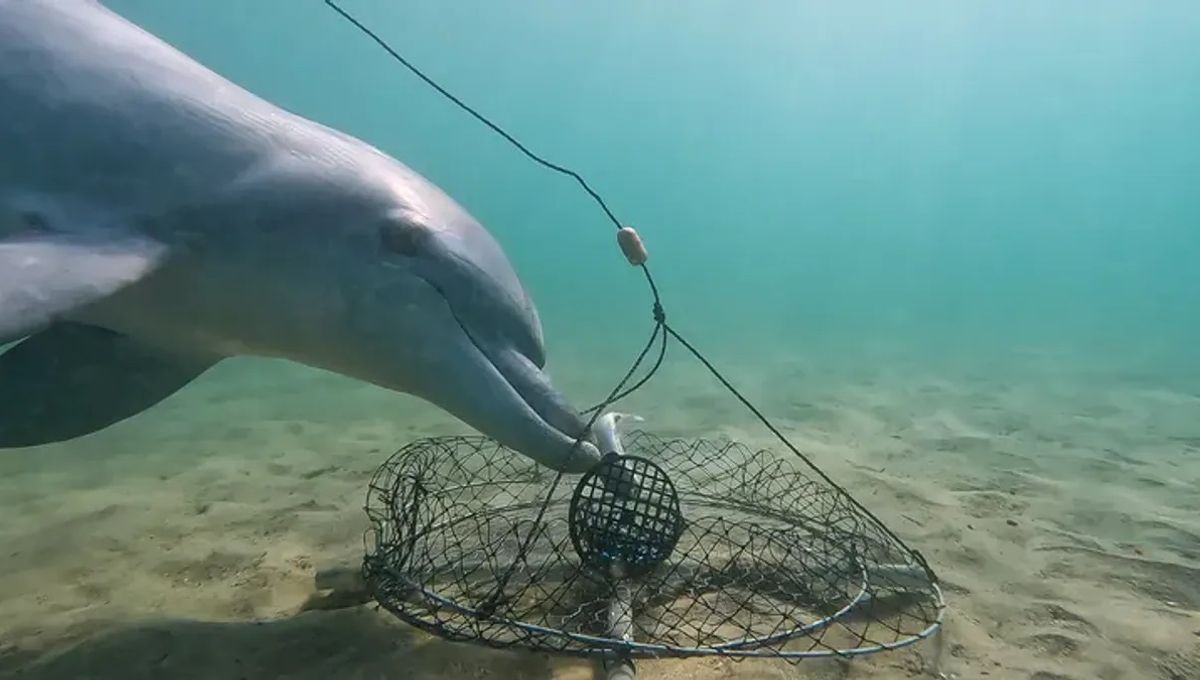
Superb film has been obtained of dolphins stealing bait from crab traps and escaping to tell the tale to their fellow pod members in what may be a unique behavior caught on film for the first time. Moreover, when crab fishers tried to make the traps dolphin-proof, their first efforts didn’t succeed for long. It wouldn’t be fair to call it an arm’s race when only one side has any, but it certainly seems the dolphins are up for the challenge of solving problems humans put between them and a meal that can’t swim away.
The city of Bunbury in Western Australia is famous for its dolphin-human interactions, attracting many tourists as a result, although fears of disease transmission have forced some restrictions. It also has a lot of crab fishers, who noticed a few years ago their baits were going missing from their traps, with no crab to show for it.
Axel Grossman, a volunteer at the Dolphin Discovery Center, took advantage of the stunningly clear water to place underwater cameras that revealed that, rather than crabs having worked out how to steal the bait without being caught, the culprits were dolphins. While beaks are less suited to springing traps than pincers, it seems brains are more important still. This is a significant achievement. Crab traps are used in many parts of the world, but nowhere else are dolphins known to have worked out how to break into the crab trap and reach the bait with beaks alone.
Even more astonishing news was in store. When the crab-catchers tried putting the bait beneath the traps, instead of on top, the dolphins quickly worked out how to flip the traps over.
Dr Simon Allen of the University of Bristol is a dolphin researcher who was shown the footage. He told IFLScience, “Dolphins have no disposable thumbs, and a completely different body plan from us. Their ancestors have been in the water for 50 million years. They have not evolved to tackle problems like this the way great apes have.” Other famous problem-solvers like crows or raccoons have had much more opportunities to work their way up through easier challenges manual dexterity can solve.
Yet without any of these opportunities for a gentle run-up, the Bunbury dolphins have worked out how to score easy meals this way, and are up for the challenge when humans raise the bar. So far the cages the crab-catchers have adopted seem to be so impressive the dolphins aren’t even trying to open them, but perhaps some cetacean Houdini is just working on their act.
Dolphins are known to be smart, but the Indo-Pacific bottlenose species (Tursiops aduncus) are the dux of the class. They’re smaller than common dolphins and prefer to live in shallower waters where the diversity of foods encourages ingenuity. The famous Shark Bay T.aduncus dolphins have invented – and taught each other – two unique forms of tool use, known as sponging and shelling, to gain access to foods that would otherwise be inaccessible, while common dolphins remain further offshore.
Allen recently co-authored a study on Shark Bay’s complex fission-fusion social network, which he told IFLScience is “The biggest social network of males outside humans,” where relationships evolve from rivals to friends and back again.
Allen said he likes to tease his UK colleagues that “Dolphins and humans are showing convergent evolution, with the Australians evolving smaller bodies and bigger brains” while those in the Northern Hemisphere go the other way. Evidence for the thesis comes in the form of a Florida dolphin that recently required medical treatment after being caught in a crab trap’s ropes, presumably having failed to replicate the Bunbury dolphins’ achievements.
Dolphin researchers are fascinated by the way new behaviors spread among marine mammals, a topic that has recently become of pressing interest to yacht-owning millionaires. Contrasting paths have been identified for the transmission of different innovations, with some spread from mother to calf, while others are transferred between friends of similar age.
Not enough is known about who sprung the Bunbury traps to know how this skill is being passed on. A mother named Calypso and her calf Reggae have been filmed stealing bait, but it is not known how many others are involved.
With the crab cages keeping the dolphins at bay, Allen doubts there will be any chance to answer this and other questions about the behavior. Returning to the traditional set-up would not only cost the catchers’ crabs, it would raise the risk that less adept dolphins might try to copy those getting an easy meal and become entangled. “It wouldn’t be ethical to use [the old-style traps] in order to study the dolphin behavior,” Allen said.
Source Link: First Dolphins To Work Out How To Steal Bait From Crab Traps Caught In The Act